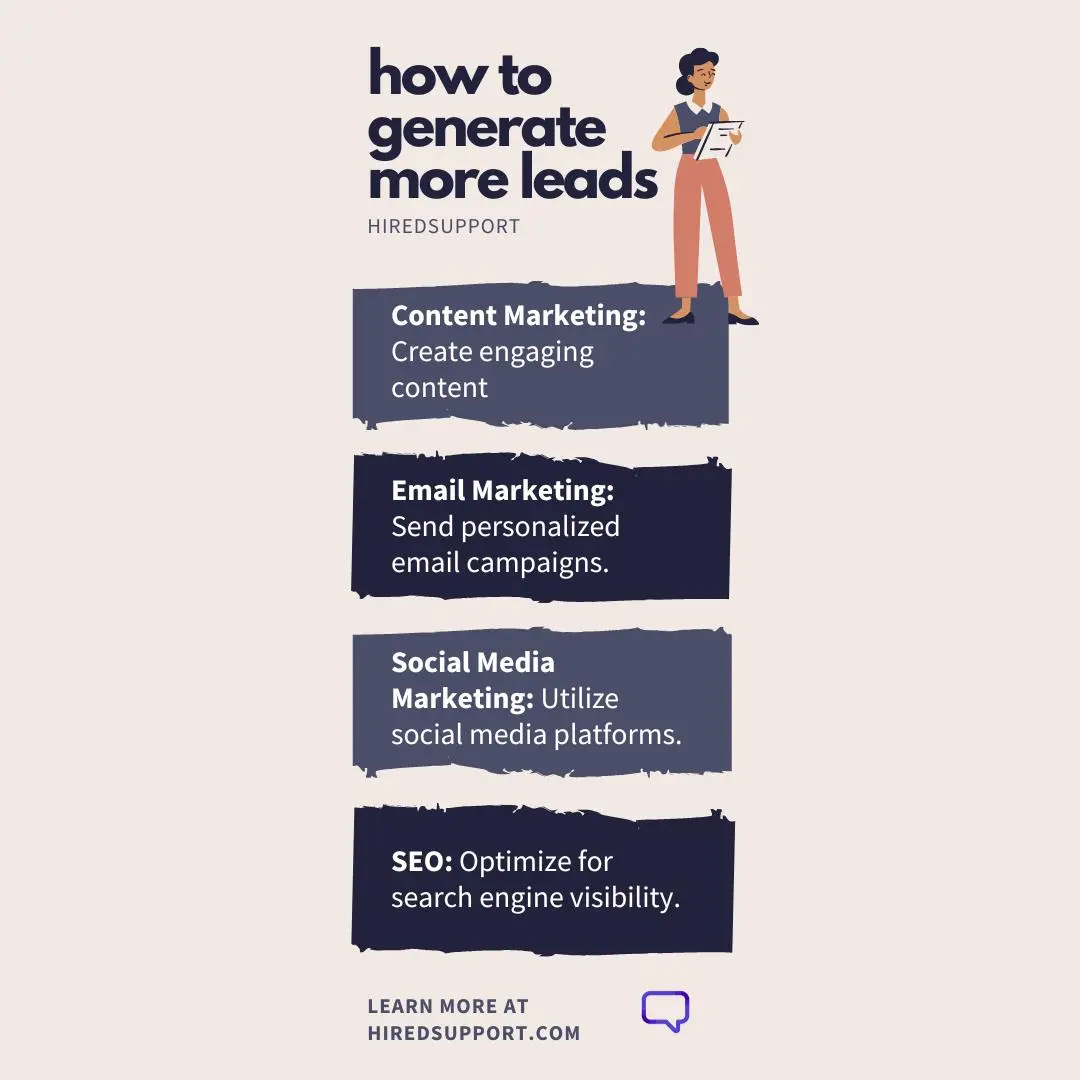Key Takeaways
- A lead is a person who shows interest in a company’s product or service.
- There are four types of leads: hot, warm, cold, and executive.
- Lead generation is the process of attracting and nurturing prospects to convert them into customers.
- It’s strategies can include job applications, blog posts, coupons, live events, and online content.
- It is important because it facilitates a natural transition from stranger to customer.
- Lead generation falls within the second stage of the inbound marketing methodology.
- Buying leads is not recommended as it can lead to spamming and harm the company’s reputation.
- Lead scoring is a technique to qualify leads quantitatively, based on their actions, provided information, and level of engagement.
- Lead generation strategies can vary depending on the platform used, such as Facebook, Twitter, LinkedIn, and PPC (Pay-Per-Click).
- B2B (Business-to-Business) companies require a different approach to lead generation, with referrals being the top source.
- It’s important to create offers for all different stages of the buying cycle.
- Using the right lead generation tools and following data can help in building effective lead generation campaigns.
Table of Contents
Introduction
According to Forbes, 60% of a typical business’s customers come from the top 20% of leads.
That said, companies need to focus their attention on lead generation for their business.
Lead generation is an essential part of any business plan, but how do you go about it?
In this post, we are going to explore the basics of lead generation and provide some insight into how you can utilize them in your own company.
Whether you’re just getting started with lead generation, or you’re a seasoned pro who’s always looking for ways to improve your process, you’ll find something of value in this guide.
In this guide, we’ll cover the basics of the process, some of the most effective strategies for generating leads, and the biggest pitfalls to avoid.
What are Leads
How do you grow your business? You need leads. Leads are people who are interested in what your company has to offer, but they are not yet customers.
They might be browsing the internet, have seen one of your advertisements, or have received an email from you.
Types of Leads
The five types of leads are hot, warm, and cold, executive, and inbound.
Hot Leads
These are people that have shown interest or have interacted with your business before but haven’t been converted into customers yet.
They are a valuable asset in the sales process and should be used with caution.
Hot leads are the most desirable because they are already in the market and looking for your product or service.
They have expressed interest in your product or service by visiting your website and even checking out your social media profiles.
Warm Leads
These are people that know about your company and have been in contact with you before but haven’t purchased anything from your company yet.
Warm leads are good because they have some degree of interest in your company but not as much as a hot lead.
They might have visited your website before but did not make a purchase yet or viewed one of your presentations on YouTube but never visited again afterwards.
These people will need a little more time and effort to get them to convert into customers.
Cold Leads
Cold leads are just starting with no knowledge about you or what your product is.
This is someone who has never been in contact with the company before and they are not looking for a product or service like yours.
Cold leads are potential customers who are not yet aware of the company and their services.
They can be targeted using various channels such as ads, brochures, and other promotional material.
Exclusive Leads
These are the people that have already purchased something from you and want to make another purchase as well as share their experience with your product or service on social media.
Inbound Leads
One of the main ways brands can attract new customers is by using content.
This is because people are willing to spend their time and energy-consuming content, and if they enjoy it, they will be more likely to purchase a product or service.
This will allow marketers to create a larger customer base without having to spend as much on advertising.
The best way to generate leads is by doing inbound marketing. It is a process of attracting users to your company through content and social media.
This marketing technique includes creating educational content, building an email list, starting a blog, owning social media channels and engaging with your customers.
The goal of inbound marketing is to build trust with potential clients and turn them into valuable customers.
Inbound marketing relies on creating content that people are interested in and will find helpful.
This can be done through blogs, podcasts, videos, or e-books.
One thing to keep in mind when it comes to generating leads this way though is that you need to provide value and not just sell them your product or service on the first touchpoint.
What is Lead Generation
Lead generation is a process that allows companies to find people who are either interested in their products or services or are qualified to buy them.
The goal is to make them customers by getting their contact information and persuading them to buy your product or service.
Benefits of Lead Generation
Leads are the lifeblood of any business. They represent potential customers who have shown interest in what you are selling.
It is important to nurture these leads by following up with them and find out their needs, so you can better serve them and, hopefully, turn them into sales.
Let’s have a look at how lead generation could benefit your business.
Necessary for Any Company’s Growth
Leads are the fuel for any company’s growth. Without leads, a company cannot grow in sales and revenue.
Leads are generated through various channels, and companies can’t just get leads from one or two sources. Lead generation is an ongoing process that needs to be maintained.
Central Part of Marketing
Lead generation is a central part of marketing. It provides a continuous flow of new prospects that can be converted to customers.
Leads Drive Sales and Revenue
Leads are important for any business. It is what drives your sales and revenue.
If you don’t have a lead, then you won’t be able to generate any sales or revenue. The most common type of leads is email leads.
Reasons for Lead Generation
The reason for lead generation is to increase the number of potential customers who are aware of your business and want to buy from your company.
The best way to do that is by using effective lead generation techniques like SEO, blogging, social media marketing, print advertising, and email marketing.
These all work in tandem with one another, but what they have in common is that they generate leads.
Why Lead Generation is Important
Lead generation is a key part of any marketing strategy.
It is not enough to have an amazing product or service, you also need qualified prospects who are interested in what you have to offer.
If you’re an entrepreneur, you know how hard it can be to find new customers. If you’re looking for a way to grow your business, then lead generation is the key.
You should know what these leads are, how they’re generated and the best way to use them.
Leads are a valuable commodity because they can help you grow your business.
So you need to carefully nurture these leads by following up with them as needed and converting them into customers when possible.
How Can I Generate Leads
Generating leads is a tedious process. But it has to be done if you want to grow your business. Below are 4 ways that you can generate leads.
Use Word of Mouth
This one of the most underrated and effective techniques in generating lead as it relies on friends and family vouching for you.
Content Marketing
This is a very popular technique in generating leads as it requires you to create engaging blog posts which will, in turn, attract more visitors to your site.
The more visitors that come, the higher the chance of converting them into leads or customers.
Social Media
Social media is a great tool for generating leads due to its global network of users with high engagement rates on posts. The best part? You don’t have to spend any money
Cold calling
Cold calling is also famous for dialing numbers of your target location and then describing your products to make them interested.
Identify Who You Want as Your Current Leads
The first step is to identify who you want as your current leads.
These are people who have shown interest in your product or service and will be more likely to buy from you than someone else.
The next step is generating these leads by using different types of marketing techniques like SEO, AdWords, banners ads etc.
A lead is a prospective customer or client.
It could be someone who has expressed interest in your product or service, or it could be someone who you have contacted to obtain their information.
One of the most important aspects of generating leads is to know what information people want and what they are looking for.
The best way to do this is by surveying your audience and figuring out what their needs are.
Determine the Value of Your Leads
The next step is to determine the value of your current leads. Anytime you generate a lead, there’s a potential for it to become a customer.
Whether they decide to buy or not, you can use them to fulfil your next sales funnel goals.
77% of a typical customer’s decision to purchase is related to the value they will receive when they decide to do business with you.
This may sound like a very basic way to spend time but remember your target market. They don’t come looking for you.
They will find you. So establish relationship-based lead nurturing with your future leads before any sales effort.
Once they become your leads, it’s important to keep them engaged with you until they make a purchase.
Looking at all this information will help you determine what marketing activities you should be doing to bring your product or service to the people who are interested in it.
Don’t just take my word for it; you have a few choices of how to calculate the value of a lead.
A potential total cost comes from all marketing related activity, like introductions, email sequences, webinars, and ads.
Before You Begin Collecting Leads
Before you begin collecting leads, you need to have enough information to confidently send marketing and sales emails.
Start by collecting demographic information, type of customer, and other info you can use in email marketing.
For example, when talking with potential clients, you want to gather their age, current and past jobs, marital status, children, pets, preferred payment method, and so on.
In addition, you also want demographic data about your customers. The demographic information can be demographic and psychographic.
It often includes things like where their company is located, who is their primary customer, and where the company is registered.
Don’t Forget to Gather Important Information
The next type of information you will want to gather is the type of client you are targeting.
You can learn things like their sales experience, objections they have, and what constraints they face.
You also want to learn about their leadership style and company culture.
After you have collected this information, the ideal salesperson is identified.
You still want to know their income level and general level of comfort with consumer requests.
Putting your salesperson persona into B2V copy will make it easier to build and market to this persona; just remember, it shouldn’t be their only marketing asset.
You have your sales team name and social media profiles that will get the word out to the right people.
Create a Lead Nurturing Plan
Once you have collected various demographic information about your targeted leads, determine what likely questions they may have.
Depending on what they want, this can be a huge part of their sales journey.
Marketing and sales emails for these leads will have to be tailored to their specific needs.
These should be developed so that each lead gets personalized attention and responses that match what they want.
Most companies send multiple emails to the same lead. Why? Because nobody wants to start receiving 20 different emails.
You can do the same thing, but ensure that they feel the same level of care shown to others.
Needing to know it better, we would advise you not to send more than 8 emails and place the bulk of your marketing attention on those that provide the most value.
Asking to follow up questions helps set expectations for sales and allows your leads to feel valued.
Asking to follow up questions shows the prospect that you care and will be open to continue the conversation.
Your outreach won’t be a one and done deal.
Lead Generation Tactics and Strategies
Understanding a variety of lead generation tactics will help you grow your business. You don’t have to rely on just one method to market your business.
While many different tactics can be used for lead generation, it’s important to not use them all at the same time.
Some of these tactics work better with others and it’s important to know what those are.
If you’re trying to generate leads, understanding these 7 lead generation methods might be a good place to start.
- Infographics
- Blog Posts
- Email Campaigns
- Social Media Marketing
- Content Marketing
- Webinars/Webcasts/Webinar Video Interviews
- Press Releases
Generating leads and sales depends on the strategies you employ. So, figuring out the right strategy is important for your success.
Some of the best lead generation strategies are:
- Advertising on social media platforms
- Blogging
- SEO
- Influencer marketing
Lead generation is one of the most common marketing strategies for generating revenue and it is especially effective in B2B environments where there are fewer competitors and usually more qualified prospects.
It is a process that can be confusing for companies that just start so here’s some basics about types of leads.
Leads come in two forms — inbound or outbound. Inbound leads come from content like blogs, etc. Outbound leads are meant to be generated from cold calling.
Steps to Generate Leads
The key to scalable lead generation is understanding your audience’s behavior and answering their needs.
Understand Your Target Audience
Identify how you can best reach your target audience: Marketers need to understand their target audience by knowing where they spend time online, what websites they read, and what social media networks they frequent.
Create Engaging Content That Resonates
Create content that resonates with your audience: The more relevant the content is for the person, the more likely they will be engaged with it.
Engage With Your Target Audience
Engage with your target audience by providing valuable information: Always offer free things such as eBooks, webinars, infographics etc.,
Use Tools
You can use tools like Google Trends or Alexa rank to see which sites people in the industry are visiting and talking about.
Lead Generation Platforms
Generating leads for a business is hard. It can be time-consuming and costly to find them. But not for long. Thanks to the internet, we now have access to more leads than ever before.
Many platforms allow you to create and distribute advertisements via social media, blogs, and email lists.
You can also use these digital marketing channels for lead generation:
- Google Display Network
- Facebook Ads
Lead Generation Sources
There are a lot of ways to generate leads for your business.
The sources you choose will depend on the industry, company size, and the resources that you have.
When you are looking for new customers or leads, it is important to have an understanding of where those potential clients might come from.
Opportunities for leads can be generated from various sources such as paid search advertising, organic searches, referrals, etc.
It is important to focus on the different channels and understand their significance in the overall scheme of generating leads.
This will help you determine where your best bet is to find new customers who are ready and willing to buy your product or service.
There are many sources of leads, yet not all are as effective as others.
For example, some sources can dry up and dwindle over time.
This is because the more people you have your message in front of, the higher chance someone will convert into a lead.
Some other sources might be less effective because they are not as targeted or personalized to the needs of your company or product.
For example, a cold call from someone who doesn’t know your company might not work well.
The internet provides a plethora of opportunities for a company to generate new leads. Let’s look at them:
Through SEO
Search engine optimization (SEO) is a marketing strategy that uses keywords on your website to help people find your business.
SEO can be carried out by an in-house team or outsourced to an agency.
Some studies have shown that more than 50% of businesses with a website generate more than 50% of their leads through search engine optimization and search engine marketing techniques.
So it’s no surprise that many companies are now investing in SEO services to maximize their ROI and reach their target audiences online.
Through SEM
If your goal is to have a qualified list, then your output marketing efforts (including PR, SEO, and PPC) should support them.
It’s okay if you can’t get your participants to buy or sign-up right away — you will get there eventually.
Running ads is like playing whack-a-mole and the goal is to keep each fly away until they find you.
If businesses are growing very fast, ads may not be a top priority.
If they are stagnant or growing at a slower pace, ads do provide a growth path. But never shoot the messenger.
If your goal is to close business quickly, then PPC may be important.
Through Email Marketing
The main goal of generating leads is to get them interested in your product or service.
This can be done by creating an email marketing campaign that engages them with the benefits of what you offer.
You should also have compelling offers that will get them to take action on what they see in your marketing material.
Email marketing is a very powerful way to reach out to potential customers and get them interested in your products and services.
But this will only work if you have the right tools at hand and know how to use them properly.
Otherwise, all your efforts will be futile and your prospects will not end up on the email list that you wanted them to.
Email marketing is becoming more popular because it is cost-effective and easy to set up. It takes time to build an email list so be sure that you have enough content before starting a campaign.
Through Social Media
Social media platforms are also a great way to generate leads for your business.
Facebook, Instagram, and Twitter all offer different opportunities for marketing success if used correctly.
Social media can take your business to the next level.
When used effectively, it can help promote your brand and help you connect with potential customers. However, not all social media platforms are created equal.
Not all social media platforms provide the kind of value your business needs.
Lead generation is essential now more than ever as companies continually look to stay relevant in today’s marketplace.
But it’s more than just looking at how many likes your Facebook post has received.
You have to take care of engagement, clicks, metrics and the content you create.
Through Traditional Media
Like print or radio ads are also successful when done in conjunction with digital marketing campaigns.
They can be used to reach people outside of your network who may not use social media or visit your website frequently.
Through Content Marketing
Content marketing is a strategy that can help generate leads for your business.
Content marketing is the process of attracting potential customers to your company by publishing content on your website or blog, and then using strategies like social media posts and email marketing to promote these posts.
The content you produce should be relevant to the people you are targeting, to convince them that they should buy from you.
If you want to generate leads, it’s important not only that the audience finds your content useful, but also that they like it enough to share it with their friends and family members.
Finding a Good Lead Generation Strategy
A good lead generation strategy will have the following elements:
- Easy to manage: It should be easy to manage.
- Cost-effective: It should be cost-effective and be able to scale up without costing you a fortune.
- Generate leads that are qualified: It is best if the lead generation strategy can generate leads that are qualified, are ready to buy now, so no chasing after them.
- Generate leads in large numbers: The strategy needs to produce leads in large numbers because businesses have high sales pipeline targets and they need more leads to achieve their targets.
- Takes company’s goals and objectives into consideration: Takes the company’s goals and objectives into consideration.
It is important to develop a marketing strategy that fits with your business’s goals and objectives.
It does not matter how well-written or innovative the campaign is if it does not achieve your company’s goals and objectives, it is worthless.
To select the right campaign, you need to analyze your company and identify what needs to be achieved utilizing marketing campaigns.
- Can deliver the specified results: It should be able to deliver the specified results within the timeline set by your company’s management team or it might result in loss of opportunities because of lack of consistency and continuity.
- Should be a win-win for both your company and the target market: It should be a win-win for both your company and the target market you are pursuing.
Your company’s long-term success will depend on your ability to understand what your target market needs, wants, and desires, so you need a strategy that will resonate with them.
Otherwise, it might not result in any return on investment (ROI).
To be specific, the more qualified leads you can generate from your campaign, the better because it means more sales—more sales mean higher revenue generation.
Do I need a huge budget for generating leads?
It is no longer the case that you need to have a huge budget, or a large marketing team, to generate leads.
The key to generating more leads is to offer your audience something they will be willing to buy from you.
If you are unable to provide them with a product they are interested in, then they will not be interested in paying for anything from you.
Generating leads is a simple process with these three steps:
- Reach out to people who are not aware.
- Reach out to people who are aware.
- Reach out to customers.
Ideally, reach out to all three groups.
Correlation between the volume of leads and profit:
According to a HubSpot research study, there is a direct correlation between the volume of leads you generate and the profitability of your business.
For example, if you generate over 10 leads per day, you will have a 49% higher profit than if you only generate 5 leads per day.
Lead generation is one of the most undervalued aspects of a company today.
It’s what will make or break your business in the end.
What’s more, with eCommerce being as large as possible, the demand for lead generation services is even higher than before.
While having a sophisticated lead generation strategy can help you reach and retain customers, the most important thing you can do to optimize your chances of getting more leads is to make sure that you focus on the right things.
Lead generation is one of those things that can seem like a black box, but once you break it down it makes sense.
The more customers you have, the more money you can generate from your sales.
Importance of lead generation in today’s economy:
Sales are the backbone of any business, whether small or large.
But the way you create and move sales leads – the content you deliver, the calls you make and the strategies you deploy – directly affects the size and quality of your annual revenue.
Lead generation is more important than ever in today’s economy.
Many companies are still struggling to generate leads and even fewer are making it a priority. Many small businesses are only generating a fraction of the leads that larger companies are.
Conclusion
Lead generation is all about creating opportunities for your customers.
For a startup entrepreneur, it can be as simple as having someone call or email them about your product or service.
Lead generation can take many different forms: Creating content to spread the word about your company creating ads to bring in new customers Listing services on search engines.
Marketing collateral, your social media accounts or your blog could all be sources of potential leads.
Many business owners still think that generating leads is something they have to do alone. They are wrong!
Lead generation strategies are easy to outsource and can bring you thousands of new leads each month.
HiredSupport can help! We specialize in lead generation services that are designed to attract, engage, and convert your target audience into loyal customers.
Our team of experts uses innovative strategies and tools to create a customized lead generation plan that aligns with your business goals.
Don’t let potential customers slip through the cracks.
Contact us today and let us help you build a robust pipeline of high-quality leads that will drive your business forward.




